Deborah Wiles's Blog, page 6
May 1, 2025
Writers Lab: letters to self
Hello, Lab Coats and all ‘bellies! Thank you for being here and for writing with me. We are working on building quite the warm-hearted community of storytellers and stories, and I am privileged to be doing this with you.
If you’re new to the Lab, please come introduce yourself here, and let us know a bit about you. If you want to be new to the Lab, you can upgrade your free subscription here; just know that we are glad to have you no matter how you want to partake at Storybelly. It’s all good, and you’ll always have access to the Lab posts until we get to The Assignment, where we go into more detail and gasp in Chat at the collective genius of the fun and the work ahead, hahaha, and as we start writing together.
Onward!
I’ve been spending some time in the past this week, both with Charlottesville (my young-adult (YA) work in progress) and with a memoir I’ve been playing with. The memoir was originally a part of Charlottesville, but it’s not working that way, as it’s no longer material that fits within the structure of the novel I’m now writing.
So I have split it off from my story about the 2017 Unite the Right rally, and I am left with a lot of material that’s not working as part of Charlottesville — what to do with that?
The material I’ve pulled is mostly 1) background on American history leading to the Lost Cause and to the Unite the Right rally; and 2) my personal journey through the Lost Cause, which — for some reason — we all thought was going to work in one book. Hmmm.
So I think I have a second book, we’ll see, but the important part, for the purposes of this Lab post, is to share some with you about Ways of Telling (Showing, Writing) and tie that into May’s Writers Lab themes… I trashed the Lab post I wrote yesterday — it’s also not working — so I’m going to start over and tweak the theme of sentimentality vs practicality in our writing.
I went down a rabbit hole yesterday, writing about personal anthems — literal songs — and the sentimentality they hold, trying to write about this in a practical way. And that personal journey has opened up a whole lot of personal material that doesn’t seem to fit anywhere, but that is definitely asking for attention — I wrote reams about it yesterday. What do you do when that happens? I’d love to hear your thoughts about this in Chat, or in comments on this post.
In my case, you tuck up into a corner of your heart the feelings it brings up, you carefully save and shelve that work for now — I’ll come back to it — and you turn your attention and skills to the more-appropriate work at hand. What do you do with the (sentimental?) feelings that it opens up, especially when they feel raw and so close to the surface?
Since that’s what I’m dealing with right now, that’s what I’ll focus on for this Writers Lab. And that’s how we’ll get into sentimentality vs practicality. I’ll use my work to highlight examples.
Here’s how I began yesterday’s now-discarded Writers Lab post:
=======
I graduated from high school in 1971 in the Philippines. My dad was stationed at Clark Air Base, the Vietnam War raged, and a “new plane,” the C5-A Galaxy, an aircraft so enormous it defied gravity, flew supplies over to Vietnam and American bodies back to the US.
This flight, from the US to Vietnam and back, was something my dad had done, piloting C-141 Starlifters in the two years we were stationed in Charleston, South Carolina. Now Dad was in charge of the flightline and terminal at Clark, responsible for meeting the C-5 as it landed to refuel, sometimes at 3am, and making sure that the war effort ran smoothly from his duty station.
I was listening to protest songs. I had my anthems. “The Eve of Destruction” sung by Barry McGuire (and written by 19-year-old PF Sloane!); “Fortunate Son” sung by Creedence Clearwater Revival; Marvin Gaye’s “What’s Goin’ On” and the ever-popular to us budding hippies in high school who were facing the draft (or loved those who were), “I Feel Like I’m Fixin’ to Die Rag” [live at Woodstock; includes the ‘give me an F’ beginning] sung by Country Joe McDonald.
And it’s one, two, three, what are we fighting for?
Don’t ask me, I don’t give a damn,
Next stop is Vietnam.
And it’s five, six, seven, open up the pearly gates,
Well there ain’t no time to wonder why,
Whoopee! we’re all gonna die.
======
So far, so practical, right? And, honestly, I’ve written so much that’s overly sentimental, and have been so dinged for it over the years by editors and first-readers, that I’m pretty good at spotting it in my own work these days.
I also know when sentimentality is called for. Romanticism and sentimentality, impulsivity and a deep quest for emotional depth are sometimes just what I need when writing something that calls for it, but those things are not more important than reality and practicality, critical thought, and some stability. The two can co-exist to great effect in writing, in art, and in life. Joined together in a kind of weird harmony, they create hope.
So. Let’s create some hope.
I’d like to spend the month of May in the Writers Lab exploring the ways in which we can work with both sentimentality and practicality in our storytelling.
Here are three first lines of mine, from three different books, all of them taking place in the fictional Aurora County, Mississippi, and all of them starring young protagonists:
“Murderers! You can’t have them all!” — from Love, Ruby Lavender
“I come from a family with a lot of dead people.” — from Each Little Bird That Sings
“Mr. Norwood Rhinehart Beauregard Boyd, age eighty-eight, philanthropist, philosopher, and maker of mystery, died on a June morning in Mabel, Mississippi, at home in his bed.” — from The Aurora County All-Stars
Astute readers have pointed out to me, over the years, that I start all three Aurora County books with… death. Well… yeah. I guess I do. So, when I wrote the fourth Aurora County novel, in 2019, I changed up my approach:
“They came, like secrets, in the night.” — A Long Line of Cakes
hahahaha. Okay, so I’m still writing about mysteries, one of which is death. I’ve been fascinated by death for as long as I can remember, but I didn’t set out to write about it… or maybe I did, subconsciously. When I was young, the idea of death fascinated me in a histrionic way sometimes, which is why the character Peach appears in Little Bird. Which is why Uncle Edisto turns the tables on death and says, “Open your arms to life! Let it strut into your heart in all its messy glory!” Now that I’m more crusty, I’m fascinated by death — and life — in a much more settled way, which is a gift of time.
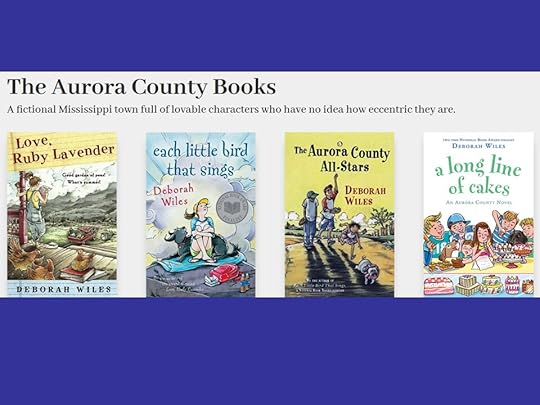
These novels contain so much hope. The urge to write about love and loss and family and connection and grief and heartbreak and joy opens vistas — vistas! — of opportunities to be schmaltzy and saccharine and silly and syrupy and sentimental. I can be as sentimental as the next person, but I’m also working with practicalities when I write, so how do I balance a story? I want it to be read. I want you to clasp the book to your breast after reading it and tell someone, “You’ve got to read this!”
The way I get to practicality within these overly-sentimental tendencies is through humor, dialogue, and… affection. There is a balance, a beautiful balance, actually, a different balance for each book, and I am always looking for it.
We’ll keep in mind this month what Wendell Berry says about the human story, no matter how you tell it:
It all turns on affection.
So let’s work with affection this week. We’ll start with letters.
Again, you can join the Lab here, if you want to write with us this month. We’ll be happy to have you, and we’ll get out the pom-poms to welcome you. :>
THE ASSIGNMENT:
April 28, 2025
my month of May
May was always my month. My parents’ anniversary is in May, my birthday is in May, and so is my sister’s birthday and my dad’s… all that Taurus energy (although Dad was a Gemini, he was on the cusp). I waited for May every year. It is my most domestic month:
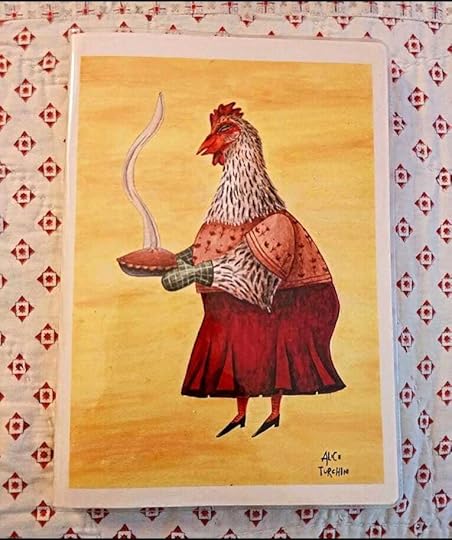 the author at home, thank you Nancy and Miriam
the author at home, thank you Nancy and MiriamHa! As a kindergartener (and in 1st and 2nd grades) at Pearl Harbor Elementary School in Honolulu, Hawaii, I strung flowers on string with my mother, after gathering them from generous neighbors’ yards. We kids brought leis to school on May 1 and danced around the maypole. When we moved to Washington, DC and my dad was stationed at Andrews AFB (a time I write about in Countdown), I couldn’t understand what happened to May Day.
May was always planting month, and it still is, for me. I can’t get it together to plant in April, although I used to start seeds in February, in their little cups, when I lived in Frederick, MD and was busy raising a family, tending a garden, and putting food by.
In those years I experimented with so many ways of knowing and understanding the world and myself. I read and wrote and sent stories to publishers in New York and was rejected a whole lot. I read and wrote more.
At one point I tip-toed through a new-age period. I studied astrology charts, I pulled runes, I read about reincarnation and karma, I consulted the tarot, and for some reason, the most ardent of these pursuits happened in May, when frosts were done and grass was greening and the world seemed to be opening up somehow.
Kinfolks in Mississippi talked about dosing and preparing spring tonics for May consumption, from their foraging and steeping in March, or April. My ongoing fascination with plant medicine and cooking from scratch grew from listening to them talk about a simple life of making do. My mother dosed us kids with castor oil in a giant tablespoon followed by an orange juice chaser. Every spring. Every May.
May was for birthday cakes and canoeing and tent camping and garden seeding and changing out the winter wardrobe for spring clothes and putting away the wool blankets on the bed, closing them into the cedar chest, and exchanging them for the cotton woven ones. New shoes. Haircuts. Plans for summer travels. Preparing for friends to move… or for our own move to the next duty station. Spring cleaning. Rug beating. Opening windows after the fall of the pine pollen. Sweeping the sills. Gathering poke when it’s still very young and cooking the leaves three times. Watching the old perennial garden come back to life with bee balm, mullein, chrysanthemum, Joe Pye, sedum, marshmallow, elderberry (always the elderberry, everywhere), witch hazel, persimmon, on and on.
Not all May memories are easy ones and such is life, eh? On my hardest birthday, I was 20 years old, turning 21, and about to have my second baby. I was alone and homesick. I found a pay phone and called my parents, collect… to wish myself a happy birthday, I guess. All I could think about in that brief moment, with a toddler clutching my leg and suffocating at my feet in this cramped phone booth and the baby in my belly pushing itself against the glass wall, the whole enterprise smelling of stale cigarette smoke and trash, was what I had thought my life would be at 21, and how hard my reality was in that moment.
I hung up the phone, opened the accordion door, picked up my daughter, kissed her hard and said, “Let’s find some ice cream.” We picked up bottles on the side of the road until we had enough of them to collect the deposit, got our money, and then walked to the Dairy Queen and split a vanilla cone. It dripped all over us and I didn’t care — neither did she. Happy birthday. It was good.
I have such a tender spot for that birthday and for those children and that moment and, still, for May.
Skip ahead many years and I was on the road in May with the books I finally learned how to write. They were published and embraced by readers, and I embraced readers right back. I spoke in schools and at conferences, glad for the opportunity to teach and hone my craft, meet my readers, make new friends, renew old friendships. More tender memories. More good years. And this year I am home. So:
I am doubling down on May. Watch out, writing desk. I’m coming for you in a sustained way. I’m also foraging and making: Pine needle tea. Nourishing herbal infusions. Seeds in pots. Watering-in. “We Built a Pond” part two. Studying the moon — did you see that sliver of super moon last night?? It’s in Taurus! Woot! Mercury and Venus retrogrades end.
I still like to pay attention to the galaxy, although I’ve forgotten most of whatever astrology I once knew. I last pulled runes probably 10 or 15 years ago, but I still have my set in its special bag, with its special cloth to set the runes on. I still like to see them on the shelf. They remind me of that me, and those days.
And I still go foraging, mostly in May. Last week I made a savory oatmeal with onions and sweet potatoes and some stinging nettle from a patch in my yard, and it was good! Come visit me and I’ll make you biscuits with butter and apricot jam and we’ll sip on some pine needle tea or — heaven forfend — nettle infusion, lol (I really love it, though). Our inflammation will subside while our cholesterol spikes, hee.
So, Welcome May. Early-early mornings for writing, just like the old days of raising four kids, writing my fingers off, and living a handmade life. Outside before the heat sets in or after the sun starts down, which I can do with long daylight. Once June hits in the South, outdoors will be so much… well, hotter. :> May is perfect. May is for all the good things on my list, the easy things, the hard things, the vanilla cones and the birthday cakes. May is sentimental. Or, I am sentimental about May.
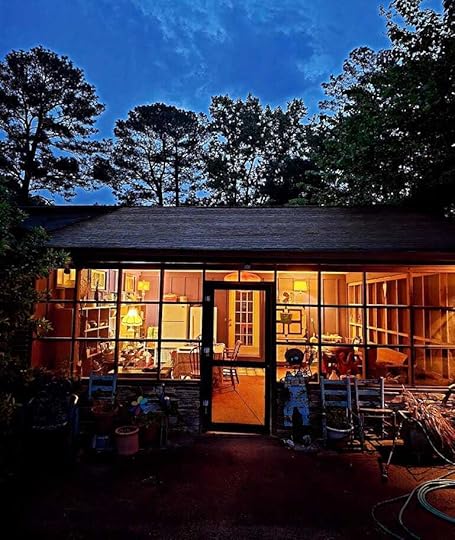 Irene, our screened in porch, just before dawn one day last week.
Irene, our screened in porch, just before dawn one day last week.This week in the Lab we’ll write something sentimental. You’ll see. We’re moving into May (still, hang on to your April notebooks) and we’ll investigate just what sentimental means (not saccharine!), and how we can write about nostalgia and what it gives our writing. If you are absolutely against nostalgia and sentimentality in your writing, come find out what it really means. Pens up, notebooks open, laptops at the ready, we’ll dive in. You can start in with us anytime; now is good. :>

There’s some sentimentality in these books, even in Kent State, the kind of sentimentality I’ll be talking about in the Lab, and there are huge nuggets, nay swaths, of nostalgia in some of them; and in all of them, you’ll find my love of home, history, and community.
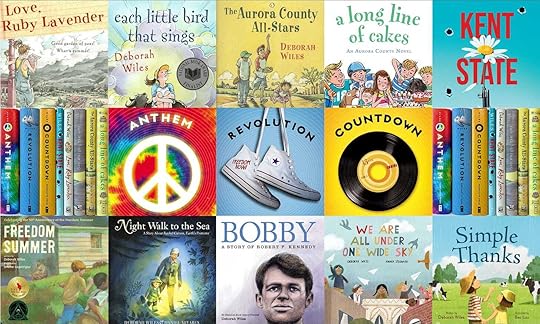
As I say every week, I hope you connect to your own home and place in history when you read and share these books. You can find out more about them at my website, here.

Whether you join us in the Lab or not, write down what sentimental means to you. What does nostalgia mean? Is it a feeling of living in the past? Is it a tug on the heartstrings? Is that bad? Good? Can you open yourself to moments, memories, meaning? Can you write about one moment in time? Here’s how to begin: “The time that ___.”
And here are some links to get you started (all links to YT). Music will play a part in our Lab on Wed. For now, listen to:
“I Love You (for Sentimental Reasons)” sung by Nat King Cole (with lyrics)
“First Day of May” by James Taylor (live)
“Month of May” by Arcade Fire (def not sentimental, or is it?)
“The Month of May” by Kellie Loder
“My Sentimental Friend” by Herman’s Hermits (live)
“What’s Forever For” by Michael Martin Murphey
What other May or sentimental songs (a million of ‘em, I know) can you think of, or do you love?
You can find me all week at Instagram or Notes here at Substack, and always in Chat, or comments on any post. Come say hey.
Have a great week!
xoxo Debbie
April 23, 2025
Writers Lab: Exercise #8
Hey there, Lab Coats, Sweethearts of the Storybelly Lab, ‘bellies, and other affectionate names for all y’all. Late start today, but here I am with some thoughts on the unity of opposites and notebooks and on closing out April’s theme. Themes. Also Exercise #8.
Next week I might try incorporating the Lab within the Digest; I’m toying with how to best communicate and in what ways, without inundating subscribers with emails (not that you have complained, but I know how it is). If you have time/inclination, will you let me know, either in comments or Chat (or DM) how it’s going here for you? I’m closing in on a 90-day trial with my employer (me) and want a review: What works, what works best, what works least, as I am ready to prepare for month 4 and beyond. I’ll say a little, myself:
I’ve so enjoyed marrying what’s happening in my life with the Weekly Digest posts and Writers Lab posts, while working to keep the themes of home & history at the forefront, breaking those themes down further with craft, creativity, books, and community posts, following (loosely, I admit) Ops-Guru Zach’s “map” for Storybelly, which also includes Chats and Zooms, and even official workshops together, eventually (we’ll get there as we grow).
I’m also hard at work on finishing a draft of Charlottesville to hand in this year, and I wonder about excerpting some of it here in its own section (not on email), or including other work in progress, much of it ideas in my head, but like priming a pump, the writing brings up ideas, eh? And I’m looking for places to house them. You? Would you go for a paid-subscribers only (that’s you, Lab Coats) section at Storybelly that is just sharing our work in progress? It would not go out in email, would only live at the top of the Storybelly home page in its own section.
Join the Storybelly Lab, if you like:
But enough thoughts on a grecian urn (wut), let’s get to the unity of opposites in stories, in… well… many things, including you. And me. And all living things.
As I mentioned in Monday’s Digest, the unity of opposites is a philosophical concept that suggests opposing forces or ideas are not separate but are instead interconnected and interdependent, that they exist together, in a state of tension and mutual influence.
According to our good friend Heraclitus (AH, this is why I am thinking of Grecian urns, I guess) the ancient Greek philosopher who, by all accounts I’ve read, was considered one depressed dude (“the weeping philosopher”), the world is constantly in flux, but the seeds of harmony and justice are held in strife.
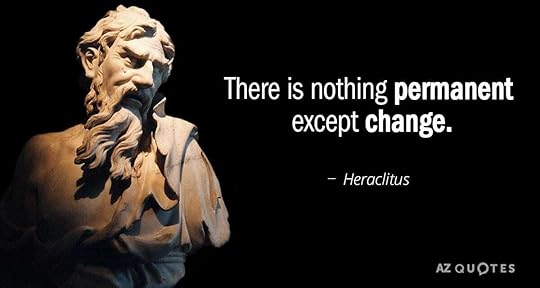 our storybelly misanthrope
our storybelly misanthropeWe are always “becoming” but never “being,” isn’t that an interesting way to look at our work in progress? (Not to mention the US, all countries, the world, the galaxy, the universe, and our Selves; no wonder ol’ Heraclitus was so melancholy; it’s a lot to take in and wrastle with in 500BC or so, eh?)
Let’s stick to our work in progress for Exercise #8, though. We’re going to write about how “everything flows,” according to Heraclitus, or — was it he who said, "No man steps in the same river twice,” I think it was he.
Change. That is the name of the game here, through that unity of opposites. Hot and cold, light and dark, up and down, in and out, yes and no, forward and backward, fast and slow.
If you are a poetry fan, you know how much poetic forms benefit from the complementary nature of opposing forces; if you write or read fiction, you realize how vital the circle is to a story, and how the necessary tension we create in that story is inspired by the villain vs the hero, the allies vs the enemies, the tasks vs the stumbling blocks.
The change that is necessary to completing the circle is, to use Carl Jung’s psychology, a “coincidence of opposites” that somehow become integrated by some sort of alchemy that creates something new that didn’t exist before that story started — a character is changed, a situation is resolved, a journey is finished, etc. The tension created by the unity of opposites is what drives your story forward.
We’re talking here about the complexities of human relationships, identity, and the nature of reality. If you’re writing sci-fi or fantasy, you are steeped in a stew of opposites you are unifying, but no less is that your task with historical fiction or even (especially!) a rom-com, right? It’s all about the unity of opposites.
We have thousands of books for young readers about opposites, even one of mine, books that help children understand basic concepts as they start to order their world. The unity of opposites exists when we start telling stories that depend on those opposites. Two that come to mind just now are (for children and their adults) Black and White by David MacCaulay and (for adults) All The Light We Cannot See by Anthony Doerr.
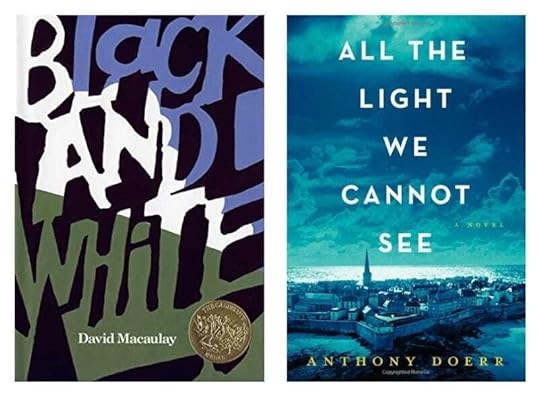 I could wax on about the beauty and magic of these two books, but since this is such a long post already, I’ll recommend them to you, or you can read more at Goodreads, which I’ve tagged for you in the paragraph above, so you can have an idea of why they are such good examples of the unity of opposites. Their reviews will also give you some good background.
I could wax on about the beauty and magic of these two books, but since this is such a long post already, I’ll recommend them to you, or you can read more at Goodreads, which I’ve tagged for you in the paragraph above, so you can have an idea of why they are such good examples of the unity of opposites. Their reviews will also give you some good background.I’m thinking of these books because of the way they actively work to show you how “opposites attract” in a way that is masterful and integral to the story they tell. In other words, the opposites in each story rely on one another for their existence. The story doesn’t exist without the interplay of these opposing forces and their subsequent transformation. In both books, each opposite shapes and influences the other, over and over. Both books involve art and geography as opposites as well.
And it’s here that we encounter this week’s work. Call it play, if you prefer. I want you to experiment! To have fun! To create!
Feel free to upgrade your subscription to paid if you’d like to write with us this week, this month, or all year long, to Chat with us, to celebrate one another’s creativity and kvetch about whatever crosses your mind with this work — all voices are welcome. And I will make a CAKE.
THE ASSIGNMENT: EXERCISE #8
April 21, 2025
the unity of opposites
I spent some time on Easter Sunday wandering the Confederate cemetery that is situated on the campus of the University of Tennessee in Chattanooga. I wandered alone, as there was no one else in the cemetery… well, no one else living, anyway. Majestic trees — oaks mostly, mixed with sweetgums, redbuds, magnolias, hemlocks, and a tulip poplar tree with a trunk probably two feet in diameter— towered over me in a fairytale, storybook symmetry. They created a vast canopy of speckled shade to walk into and out of, and provided relief from the 86-degree afternoon sunshine.
“I knew it,” I whispered, bringing my research to mind as I came upon the informational sign about the cemetery’s origins. The United Daughters of the Confederacy were right there/here, along with the Sons of Confederate Veterans, in 1913 when this plaque was dedicated after a flood in 1867 resulted in the 1901 relocation to higher ground of the original graves that had been too close to the Tennessee River. (What a sentence!) “In these sacred grounds the sons of eleven southern states are buried.”
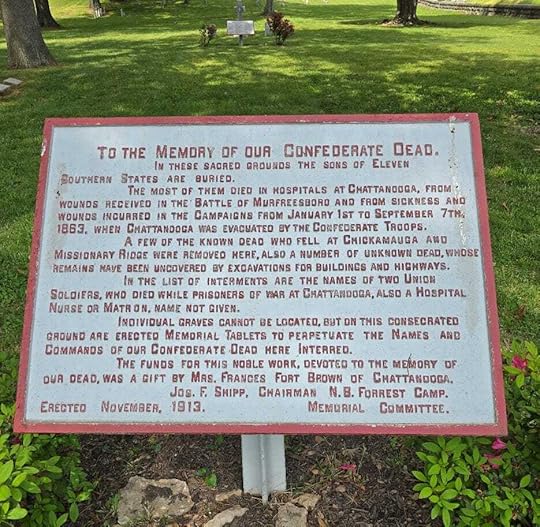
Sacred grounds. Southern sons. Mothers’ sons, 260,000 of them in the Civil War. More or less, I mean, who really knows? This is an estimate from the National Parks Service:
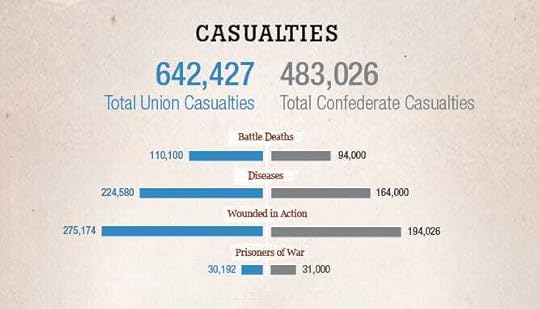
That’s a lot of dead Americans, mostly men, mostly white men, fighting to… what? To preserve democracy? To preserve slavery? To promote a more perfect union? To secede and form a different union? Here is the Preamble to the US Constitution:
We the people of the United States, in order to form a more perfect union, establish justice, insure domestic tranquility, provide for the common defence, promote the general welfare, and secure the blessings of liberty to ourselves and our posterity, do ordain and establish this constitution for the United States of America.The Civil War decimated families and systems and traditions in both the South and the North. Statistically in the South, the numbers of dead were exponentially higher when compared to total population numbers across the North and South so that there were few families that were not touched by death, dismemberment, and mental incapacitation for the Southern survivors. The lack of federal funding and support for recovery after the Civil War meant the economic collapse of the South, a collapse the South has never fully recovered from, partly because of her own choices — slavery, Jim Crow, the Lost Cause among them.
And it’s not just the South that suffered, is suffering. It is America. We are one nation. When one is hurting, all are hurting. When one is lost, all are lost. This is one reason stories are important, as they have the power to lift us up, and to show us our humanity, if we let them, if we tell them, if we listen to them.
The City of Chattanooga distanced itself — actually, detached itself — from any funding or maintenance for this cemetery after the 2017 Unite the Right rally in Charlottesville, Virginia, when cries for defunding and removal of Confederate statuary became louder and more pronounced in the US. (The 8-sec video below is of the Stars & Bars, the original battle flag of the Confederacy, fluttering over several Confederate graves in the cemetery on Sunday.)
It is very hard to imagine this quiet place as a battleground this Easter Sunday afternoon as I wander through it, although I know we are still a battleground in the US today. I think about the “unity of opposites,” a phrase that was new to me in 2002 when I had a conversation with Adam Rapp at Vermont College, in his semester teaching there. He wondered, when I talked about my work in progress (an unsold novel, still today) whether two girls who think they hate each other might actually be attracted to each other. Tell me more, I said.
The Unity of Opposites, he said, is a literary (and philosophical) concept that suggests opposing forces or ideas are not separate but are interconnected and interdependent, that they exist in a state of tension and mutual influence.
So I looked it up (ha!) and read more about it, and decided that my two girls, Birdie and Margaret, who, it so happens, are related, are definitely not attracted to each other in the way that Adam was suggesting, but they definitely rely on each other for their existence. Just as we in the North and South (and East and West) rely on one another for our existence. Just as family dynamics, in all their light and dark facets, influence who we are, individually and collectively.
What does that mean for the book I’m trying to write? What does that mean for the battles we are currently waging with one another?
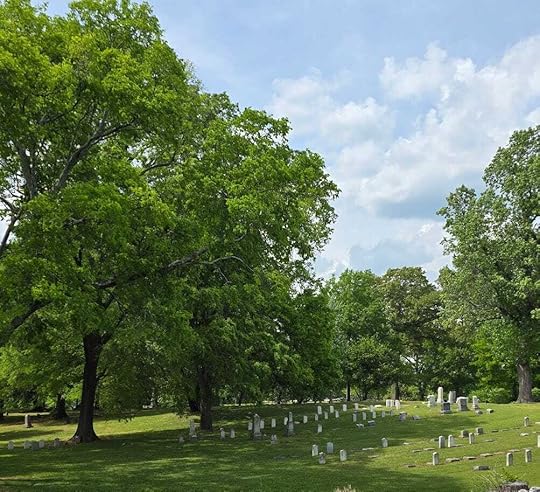
On Easter Sunday, the only car that passed by on the lonely road next to the cemetery was driven by campus police, who slowed down to check out my car with the Georgia plates, the only car parked on the side of the road. I waved, a woman of a certain age wearing sensible shoes, an overflowing dress and newly cut graying hair, and the police officer nodded from his cruiser — nothing to see here — and moseyed on his way.
What would I have said if he had pulled in front of my car, gotten out of his, and asked me what I was was doing, a stranger in these divisive times, wandering this cemetery from out of state, on a quiet Easter Sunday afternoon, all by myself?
I thought about that as I wandered:
I’m researching a book about the Lost Cause of the Confederacy and the Rise of White Supremacy — No, I wouldn’t say that.
I’m a Southerner researching my family tree, as I had kin who fought for the Confederacy and died in the Civil War — No, not that.
I want to understand how I grew up in the lap of the Lost Cause and how I am the only member of my family-of-origin who walked away from it, and how that can be, and what purpose can the Lost Cause continue to serve? - No, definitely not that.
I’m trying to figure out how to write a book about how divided we seem to be as a nation right now, while wanting to say we are more alike than we are different, and we are stronger when we stand together — No, not this either.
I want to honor the humanity in all of us while I write about the atrocities of war and the possibilities of peace— No, who says that?
I am lost and want to be found. I can’t understand how we kill one another in this country, and how complex are the issues, how foundational is our greed, and our generosity, and I want to know how real change happens — No, unnecessarily theoretical.
I am here because I miss my family and I love them — No, they are not buried here. Or are they?
No. No to all of it, and yet, yes. Yes to all of the above. And maybe all of those statements above are this statement:
I’m here, and I’m writing this book, because I believe in the unity of opposites that I work toward in every book I write, and I believe in finding and honoring that unity of opposites, in this one life that I have to live. Yes.

This week in the Writers Lab we’ll use your handwritten daily lists in your notebooks (start now if you haven’t yet) to work on an exercise that incorporates — you guessed it — the unity of opposites.
We’ll keep working on a daily 5-minute list (Exercise #6) and on last week’s Exercise #7 to pick one of those lists to write a short piece about. The month of April is all notebooks, all the time.
Nothing is ever wasted, not with what we write, nor with any day we live. To wit:
I came to Chattanooga for an impromptu Girls’ Weekend with my younger daughter and her daughter, who is a delightful age two — wheeee!
","alt":"","staticGalleryImage":{"type":"image/png","src":"https://substack-post-media.s3.amazon...We stayed in downtown Chattanooga. In our two and a half days we managed to ride a steam train at the Tennessee Valley Mountain Railroad; buy cast iron seconds at the Lodge Factory Store; swim in the hotel pool; walk across the Chief John Ross Bridge (because the pedestrian bridge was closed for renovations) and didn’t realize until halfway across that it was a bascule bridge (what I call a drawbridge) so the planks in the middle section were particularly… challenging; watch some Bluey (of course) with our picnic suppers in our room; and go to the Chattanooga Zoo to see the new baby giraffe and expire in the heat. lol. Talk about a unity of opposites. There was even a ride on a carousel.
When we left one another to go home late on Sunday afternoon — me to the South and my two loves to the West — the Confederate cemetery beckoned to me, just 4 minutes away, and so I went. Another unity of opposites: the time with my girls and then time with the dead… two opposing forces or ideas that are not separate but interconnected and interdependent, that exist in a state of tension and mutual influence, on that same day, for me. Something like that.
The cemetery’s protective trees that gently shelter the slaughtered dead — another pair of symbiotic opposites — reminded me of the oak grove in the tiny town of Louin, Mississippi where my dad grew up, the town that becomes Halleluiah, Mississippi, in Love, Ruby Lavender, All-Stars, and Cakes (and Freedom Summer as well), and where I spent my growing-up summers. I felt embraced there.
My task ahead is to embrace that unity of opposites that existed long ago, both in my life and in the life of my story, marry the past with the unity of opposites that we live in today, and invite readers to make connections to their own lives and stories… to understand that we are not separate but are interconnected and interdependent, that we exist in a state of tension and mutual influence, that we can choose what that influence will be… we can make different choices.
I’m very glad to have a place I can write about this with you, as I write forward with Charlottesville. I’ll be back at my desk tomorrow. Thanks for coming along.

Books that encompass the unity of opposites we all live with, in family, in community, in history, within ourselves:

As I say every week, I hope you connect to your own home and place in history when you read and share these books. You can find out more about them at my website, here.

What about your own experiences with the unity of opposites? I could tell you about my Krispy Kreme experience in Dalton, Georgia on the way home — an excellent study in opposites and how they inform each other — but I’d rather hear about yours. I’ll have another accidental doughnut while you tell me all about it. :>
And that’s this week’s rumination, oration, delineation, occasion for pontification. We are heavy into spring now, and I hope to plant this week!
Tell me what you are up to in this last full week of April… I’ll chronicle the same in Notes or on IG or… I’m thinking of dusting off the blog for more personal stories, since Storybelly is more of a legacy project, but we’ll see. You’ll hear about it here, regardless.
xoxo Debbie
April 16, 2025
Writers Lab Exercise #7 Notebooks Part 2
Welcome new Lab Coats! Welcome Everybody! The ‘bellies. :>
Good day-after-US-tax-return-filing-day, Lab Coats. I walked into my study at 5:30am this morning and blinked: it’s as if everything in this room got drunk last night and passed out, after vomiting piles of paper everywhere. Yikes. But… it is done, finished, for another year. How’d you do, if you are here on American soil and must file a return every April 15?
If you were done in January, or last week, like a rational person files taxes, please don’t tell me. I live for the illusion that we are all, collectively, pulling out our hair on the night of April 15, looking for that one piece of paper we need in order to finish filing. This fantasy justifies my disorganization. Or should I rename it “my creative genius.” hahahahaha. (Madness, more like it.)
Having got that heave-ho out of my system, let’s get down to business.
* * * *
Lab Coat , who writes the lovely Substack “Notes From the Path,” provided my inspiration for this week’s Writers Lab assignment. Thank you, Becca! We are still working with notebooks and writing by hand through April, still gathering material in our notebooks in whatever fashion suits us (see CHAT for my examples over the week), and this week we’re branching out with those notebooks.
Becca wrote a post on Friday that included an excerpt from poet and writer Donald Hall’s The Best Day the Worst Day. The excerpt:
What we did: We got up early in the morning. I brought Jane coffee in bed. She walked the dog as I started writing, then climbed the stairs to work at her own desk. We had lunch. We lay down together. We rose and worked at secondary things. I read aloud to Jane; we played scoreless ping-pong; we read the mail; we worked again. We ate supper, talked, read books sitting across from each other in the living room, and went to sleep. If we were lucky the phone didn’t ring all day. Three hundred and thirty days a year, we inhabited this old house and the same day’s adventurous routine.
It’s a list of sorts, eh? It’s written in a circle, beginning-middle-end, a day. It possesses the qualities of poetry, and yet it is written in very plain language, very simply, nothing flowery or overwritten or full of shimmering imagery. Hall doesn’t need that, to tell this story. Declarative sentences, that was his choice here, declarative sentences put together in such a way that the rhythm rocks you gently through the description of the day. Ah, to have such days! They are such a gift.
The tone of that excerpt and the way Donald Hall listed the simple yet elemental moments in that day reminds me so much of Hall’s book for young readers and their adults, Ox-Cart Man, illustrated by the fabulous Barbara Cooney, published in 1979, and winner of the 1980 Caldecott Medal.
I have read this lovely book dozens of times to my own children, and I want to share it with you. A quick look at YouTube gave me this reading by Lorne Greene (!) which is originally from Reading Rainbow. The images are grainier than I’d like, but I love the reading so much (and the way the art moves from time to time), this is the one I chose for you. I would like you to think about your listing, notebooks, writing in a circle, writing longhand, the simplicity of living, and a life well lived as we investigate this book and this week’s work together. Have a listen/watch:
It’s masterful, isn’t it? A beautiful, meaningful package, the words and the illustrations together. Here’s the logline (remember loglines, from our very first Storybelly Digest?): A lyrical journey through the seasons and passing years of one New Englander's family evokes the feeling of historical America.
Well, that’s one way to put it, and just one look at historical America (New Hampshire to be exact) in the 19th century. We might craft a different logline for today’s more encompassing views of historical America, but for the purposes of this book (and the current assignment), I want to appreciate this book for all that it is; it has a lot to teach us as chroniclers of our everyday lives, turning personal narrative into fiction, writing poetry, memoir, vignettes, and all the tools that go into these endeavors.
This book grew out of a story passed down in Hall’s family that became a poem Hall wrote and published in The New Yorker. It was also called “Ox-Cart Man.” Listen to him read the poem here. Notice how different is the poem from the picturebook:
What do you notice? The original poem is here.
In this 2018 essay at Slate, written by Johanna Winant and titled “Rereading the poet Donald Hall’s beautiful children’s book Ox-Cart Man in a time of turmoil,” we get a close reading of both the poem and the book, and see how each holds different meanings, both important, and yet how much richer and more lyrical is the revised/rewritten/expanded poem that is the book.
I am assigning this essay as required reading for this week’s assignment. :> Overall, what I want you to remember, as regards your own work, is this:
Ox-Cart Man could be dismissed as patriarchal, capitalist, and nationalist in its celebration of a New England yeoman farmer—Hall is not usually thought of as a political or particularly progressive poet—but instead, this book assures me that all our work holds good, even if we can’t see the long-term effects from here.
All our work holds good. I love this, and I believe it, even if we can’t see the long-term effects from here. We just begin. Please begin.
Winant goes on to chronicle how Ox-Cart Man was a poem in The New Yorker and then morphed into a children’s book. Here’s some of what she notices:
The original poem is austere, with five stanzas of five lines each, and essentially no imagery.
and:
In the original poem, though, the man is alone.
and:
The addition of the family changes the poem from one man’s annual toil to a story about what we hope to do for the people we love, and how we hope to alter the future, just a little, for good.
The addition of the family gives the poem/book so much relativity and resonance as well. We write books for young readers in part so they can see themselves reflected in them, and understand their world and the context within which they live. Books for young readers have a different mandate (if that’s what it is) than poetry that is, in this case, meant for an adult audience. But the connective tissue is there, when we look. They are more alike than they are different.
Winant says it better than I do:
The family’s love, which is not separate from duty or labor but part of both, is transformative. It transforms yarn into mittens and shawls, wood into brooms, seeds into food, and feathers into clouds. The original poem of “Ox-Cart Man” denies that anything will ever change and asserts its recurrence. The children’s book shows how just the opposite can be true.
The endless work of living in the world, which Hall details in both the poem and the book, comes alive in a different way in the book, with a richness and hope and warmth and imagery that pays homage to those we love and speaks to our interconnectedness and the longing of the human heart for a kind of completeness and belonging, community. That’s what the book gives us — all of us, not just young readers.
The movement from practicality (listing in your notebooks all this past week) to poetry (and prose) will be part of this week’s assignment.
So! Notebooks to hand, pens poised, and let’s go! If you want to sub to the Writers Lab here at Storybelly, the only paid portion of our site, you can do that here. You can sub by the month or by the year, we welcome anyone who wants to play with words, with their own narrative writing, turning your story into sketches, fiction, poetry, essays, memoir — it’s all good, and so are we; we are here to share and have fun in a space that is welcoming, comfortable, and supportive. See you down below!
THE ASSIGNMENT:
April 14, 2025
Beginnings
Good afternoon, ‘bellies! Okay, you are not ‘bellies, but I feel awfully affectionate toward y’all today as we move into a third month with Storybelly and start to hit our stride with home and history and all things story. I’ll write an essay today and not worry about categories. You already know I write about home and history here every week, and with every book I write. So lets get to it.
As I drove home in the dark from Charlottesville last week, I listened to the playlist from Anthem, curated by reader and librarian Sarah Ralph, which you can find here, on Spotify (whether you have an acct there or not, I believe), if you are teaching or reading that book. Thank you, Sarah!
The music on Anthem’s playlist pulls me into the 1969 world of Molly and Norman and Ray (who makes an important appearance fresh from Revolution/1964, five years older now); into my own world in 1969; and into the writing of that book.
There are 47 chapters in Anthem, each of them anchored by a song from the late Sixties, and each of them doing the lifting that gives us atmosphere as well as information for that chapter and context for the book as a whole.
There are seven scrapbook sections in Anthem. They are there to serve as context for readers of all ages, and for all types of learners. I was struck by my many years of writing with students in workshops to realize anew that history was a series of dates, places, and people to them, instead of a multi-faceted mosaic of connecting and coinciding events large and small, and I wanted to show readers that mosaic.
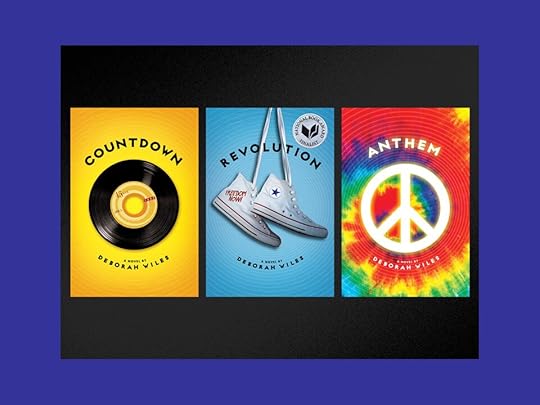
Hence, the documentary novel was born. I wrote three novels of the 1960s, each a stand-alone story, with scrapbooks of clippings, photographs, and other ephemera of the times: in Anthem I concentrate on the Vietnam War, the counterculture, civil rights, and rock-and-roll. Some stills from Anthem’s scrapbooks are below. You can download Scholastic’s discussion guide for the Sixties Trilogy, or just peruse it, here.
The song I listened to on repeat for a while, speeding through the dark toward home, was “Beginnings” by Chicago.
Only the beginning/Only just the start
That song begins chapter 46, as Molly and Norman make the decision to head home in that wildly painted school bus of theirs, with an extra surprise passenger, and with all the adventures they have had driving across the country from Charleston, South Carolina to San Francisco tucked into their minds and hearts… all those stories of America in 1969.
Then, the next (and last) chapter is short and concludes with a look forward for these young people, to the tune of “America” by Simon & Garfunkel.
They’ve all come to look for America.
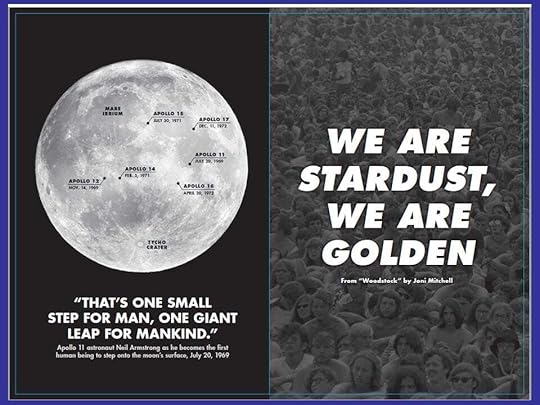
I’ve thought about this ending so much in the week that I’ve been home, about beginnings and America. I’ve thought about all the hope that this ending of Anthem holds for the reader, for Molly and Norman, and for me. I’ve thought about how much I love this country, America.
The book I’m writing now, about the Unite the Right rally in Charlottesville, Virginia in 2017 — well, one draft of it — begins at the beginning of America, with Virginia Dare and the Roanoke Colony and the mystery of what happened to them, and even before that, with purple mountains majesty and running streams and rushing rivers and “lions and tigers and bears oh my” and the first inhabitants of this country, the Indigenous peoples who lived close to the earth, before there was the name “America” given to this country by what could only be seen by the Indigenous, eventually, as “invaders,” a word I’ve come across dozens of times in research about the North “invading” the South and the origins of The Lost Cause of the Confederacy and the Rise of White Supremacy (which was my original title for Charlottesville).
 Charlottesville, Virginia, Aug 11, 2017 photo: getty
Charlottesville, Virginia, Aug 11, 2017 photo: getty Every ending is another beginning — I teach that concept in every crowd or clutch of students I stand with in workshop or assembly, exhorting them to believe that the breath, the day, the person — them! — the country is a story, that the end of one breath is the beginning of another, the end of one day is the beginning of another, that the long night passes and “joy cometh in the morning,” or at least the tasks of cleanup and an assessment of damages and a plan for rebuilding, restoring, or in the case of a manuscript — and, often, a life — a plan for revising and rewriting. A plan for understanding.
“Every human being is worthy of dignity and respect, and every person’s story is important.” My constant refrain, I know, and now more than ever. It’s why we’re building a writing community here at Storybelly.
Story is the most powerful change-agent on Earth. Just like history is a mosaic of events weaving into one another… that’s America, too: a crazy-quilt of different religions, cultures, colors, creeds, arguments, compromise… We are a nation of stories, and telling those stories in any form they take — written words, songs, pictures, spoken words — this is the path to peace.
You can share this post with whomever you wish — we need all the stories we can get now. Write what’s on your heart. I’m so happy you’re here.
Share Storybelly with Deborah Wiles
This week, if you want some suggestions on what to write, listen to “Beginnings” and then to “America” and write in your notebook what comes up. That’s enough. That is everything! There is a line in “America” that might also call to you:
Kathy, I’m lost, I said, though I knew she was sleeping
I’m empty and aching and I don’t know why
Post what you write below in comments, so we can all see and share. I will, too. If you want more specific writing instruction, you can join the lab, here.

Here is my Home & History this week, all are stories that come directly out of my life, even though they are fiction:

As I say every week, I hope you connect to your own home and place in history when you read and share these books. You can find out more about them at my website, here.
Until next time. Go gently, and take care of one another.
xoxo Debbie
April 13, 2025
LAB extra: Exercise #6, recast:
Good sleeping-in Sunday morning, LabCoats (is this one word?). Debbie here, still recovering from a cold, with a re-cast of Exercise #6 that’s going out only to paid subs today as an “extra” or a clarification, courtesy of our ops-guru Zach, who is doing the exercise this week and came to me with:
You know… you could streamline this conversational tone so subscribers would know exactly what you’re asking them to do… make the assignment clear, then tell us how you’re doing it, then give us your insights and explanations, and include all those supporting links to the wonderful substacks you linked to that enrich your point…. as it is, I had to read through it pretty carefully to get the gist so I could do it myself…”
Okay, I won’t push back. I am conversational in workshops, in person (and repetitive there, for obvious reasons), whereas, here on Substack, you have me captured on the page and can refer back at your leisure. So:
Here is the same Exercise #6, re-cast by Zach. What is an ops …
April 9, 2025
Writers Lab: Exercise #6
Welcome to new Lab Coats in the Storybelly Writer’s Lab this week! Be sure to visit the Introductions in Chat and introduce yourself to the Lab Coat community (aka Sweethearts of the Storybelly Lab) and see who else is here. Subscribers get access to the Lab Chat where we share our writing and get lots of support and good cheer; Lab Coats can start threads and also have access to all previous and future Writer’s Lab lessons and assignments. Questions? Drop them in the comments here (or DM me) and they will be answered promptly by me or by our Lab Coat Ops Guru, Zach.
The first half of the Writers Lab weekly posts and exercises are open to everyone in the Storybelly community, right down to the assignments section, because I want everybody to have access to what goes into writing our stories and ways of capturing and telling those stories. Then, the assignments section builds on everything previous, goes into detail, and assigns… well… the assignment each week.
Free Advice (a la Ruby Lavender): IT IS FUN!
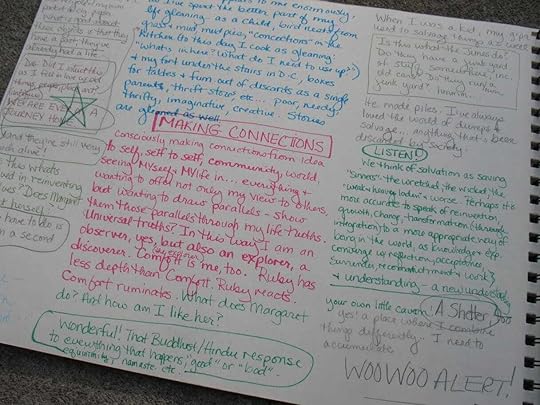 a page from a large art tablet I used in 2005 to figure out an unsold novel that I still love and want to go back to someday. Revisiting this is a powerful and uplifting experience! Makes me want to pull out the ms and get to work.
a page from a large art tablet I used in 2005 to figure out an unsold novel that I still love and want to go back to someday. Revisiting this is a powerful and uplifting experience! Makes me want to pull out the ms and get to work.There is no requirement to be a professional writer, artist, or anything else, although, great if you are, we love you, too, and you have much to teach us/share with us (and I’ll bet you have good cheerleading skills :>). You need only be a real human, with a desire to create, to learn to write your story, or hone your craft, or work together in a chosen, warm-hearted, smart, creative, funny (we have SIFTERS!), helpful, practiced — and beginner — bunch of storytellers. It takes all of us. (We have a bunch of Ray Bradbury fans here, too!)
We’re here to experiment, to play, to work hard if that’s our jam for the week, to bring with us a work in progress or to begin something new — every week. For whatever purpose suits us. We are focused on personal narrative writing right now, with extra added “turning personal narrative into fiction” sprinkles. Let’s get to it. The Lab is the only paid portion of Storybelly, by design, to create a write-together community where we can delve into and get to know our own work well, and to champion one another’s work as well.
If you want to join in, here’s your link:
Onward! The first thing I thought, when I so blithely declared that April 9 would be the start of (the second half, actually) the spring quarter at the Lab was:
Lawd, this next Lab post will be long and full of links. Pace yourselves. :> And welcome to the second half of our spring quarter at the Storybelly Writers Lab!
As you know from Monday’s Digest and from last week’s Lab post, I worked in Virginia schools last week, encouraging students — and their teachers — to tell their stories, getting them started with same, and telling them that all story comes from what we know, what we feel, and what we can then imagine; that we pay attention, ask questions, and make connections when we’re writing; and that those three elements present themselves as 1) the moments of our lives; 2) the memories we have of those moments; and 3) the meaning we give them.
I have completely made up this “system” or “method” or what-have-you, over the years that I have worked with many, many thousands (literally) of students, teachers, undergraduates in college classes, families, and senior citizens and have tried to bring real-world writing tools to my students in workshop settings in ways that — put simply — help. Surprise. Produce results. Results that are sometimes breathtaking (you didn’t think you had it in you, did you?) This way of approaching story is an effective and meaningful way of thinking about and writing our stories. Here’s a helpful chart:
First read each column down, before moving on to the next column, then you can read across, i.e. “What you Know” corresponds to "Pay Attention” and “the Moments of your life.” Etc. Make sense? Spend some time here, thinking about these connections.
All Story Comes From:
What you Know // Pay Attention// Moments of our lives
What you Feel // Ask Questions // Memories we have of them
What you can Imagine // Make Connections// Meaning we give to them
I’ll ask our ops-guru to make us a box or a graphic for this. I’ve meant to do it, for ages… I’ve written it many hundreds of times on chart paper in workshops, and now we’ll have it enshrined, here at the ‘belly.//
These are my foundations for writing. This is IT. This is ALL of it. Except, of course, the HOW is missing, the breaking down of how we figure out what we know, for instance, and how MUCH of it we want to include in what we’re writing (i.e. what corner to “bite off” with this particular piece we’re working on, that’s an old saw, eh?), and HOW we pay attention, or WHAT we can imagine, and on and on. What are the questions? How do we get into the habit of making connections?
Making Connections — that’s one of the most important aspects of writing well. And that’s where I want to start in this second half of the quarter. The first half was for getting to know one another, for playing around with where to start us off, seeing what you felt was useful, meaningful, and important. Remember that nothing you write is ever wasted. Hold on to what we’ve done so far; you may want to bring it into this second half of the quarter, or tuck it into your writing toolbox for another time.
So: Connections. The way I want us to start thinking about making connections is by USING A NOTEBOOK. It can be digital if that’s truly your preference, but, just as I have requested in countless high schools (heck, all schools) for over 20 years, and as I saw laptops become the order of the day, students traipsing (and sometimes trudging) into workshop with their electronic writing devices tucked under an arm, I request that you try using a physical notebook with real paper and a real writing instrument for taking notes this week… and all through April.
It doesn’t matter what size notebook or what kind. I have used every size and type under the sun — small, huge, three-ring, spiral (fave), composition, art tablets, etc etc etc. I keep them stacked in piles in my closet, rubber bands around many of them, the dates they were used on the front of all of them. What’s in my notebook often turns into a book, a short story, an essay, a poem… or a shopping list. :>
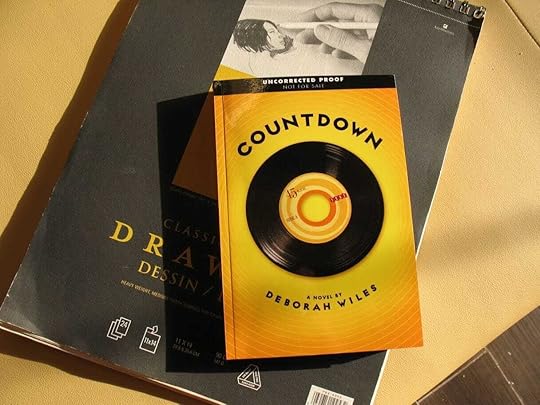 the big art tablet that turned into Countdown
the big art tablet that turned into CountdownThat’s not a boast (as if you’d think it was, but I’m always fearful of coming across that way); it’s a teachable (I hope) moment of saying there is a synergy that happens between the brain and the hand, between the mind and the words on paper, that yes, happens when you’re typing, but that happens in a different way when you’re writing by hand. It doesn’t matter if you use cursive or print. If you are sloppy or neat. Long or short. Writing longhand is what matters. There is a meditative element to it, and your retention of what you’re writing and learning is enhanced.
On Substack, makes this case in “A Defense of Writing Longhand.” He says:
“But there is obviously more to writing than typing. What I'm really doing is composing. Composition requires focus. It is, like most acts of creation, monotasking.”
That’s part of it. You’re composing when you’re writing, but we aren’t writing yet (well, we are, but it’s different, trust me). We are taking notes. I would like you to take notes this week. Lots and lots of notes.
I know many of you already use notebooks, whether for Morning Pages (I see you!), for drawing, or for keeping your daily life on track. All good. We’re going to be exploring all these uses (and how they lead to story) in April.
You can find a plethora of Substack authors who give you great advice on the value of writing by hand in a notebook, and even share the kinds of notebooks they use, and for what. Some of them use multiple notebooks, all at the same time! More power to ‘em! I can’t do that, I’ve tried. I can use one notebook at a time, and fill it with everything. EVERYTHING. From grocery lists to the score in games of dominoes, to grandgirl art, to story ideas and everything in between. My notebooks end up being glorious accountings of my days. Well, glorious to ME.
You likely know about ’s many paeans to “analog” notebooks. Here’s “My 4 Notebooks and What Goes Inside Them.” Then see with “For the Love of Notebooks.” has resources galore on notebooks (her Substack is even called Noted), and for those who love and work with music, like my musician husband Jim does, here is an entry on The Beatles’ collaborative notes and three ways to write a song. I love this:
“Just say whatever comes into your head each time.”
Amen, brother!
I’ll leave you with this Note from , in which Matthew Long writes about Journal Porn, lol, and it’s good!
I could go on — there are so many examples, and they are all delicious. I’ll stop. We have an assignment to wrangle. It’s a good one. We will build on it from now until May, with ever-more experimentation each week. Here we go. Once again, you can upgrade your sub and join us in the assignments, here:
Or, if you aren’t subbed to Storybelly yet (almost all of it is free content) you can sub here:
And you can share this post anytime, with anyone you wish:
Share Storybelly with Deborah Wiles
Okay! Next:
THE ASSIGNMENT:
Writers Lab: The Great & Powerful Notebook Has Spoken
Welcome to new Lab Coats in the Storybelly Writer’s Lab this week! Be sure to visit the Introductions in Chat and introduce yourself to the Lab Coat community (aka Sweethearts of the Storybelly Lab) and see who else is here. Lab Subscribers get access to the Lab Chat where we share our writing and get lots of support and good cheer; you also have access to all previous and future Writer’s Lab lessons and assignments. Questions? Drop them in the comments here (or DM me) and they will be answered promptly by me or by our Lab Coat Ops Guru, Zach.
The first half of the Writers Lab weekly posts are open to everyone in the Storybelly community, right down to the assignments section, because I want everybody to have access to what goes into writing our stories and ways of capturing and telling those stories. Then, the assignments section builds on everything previous, goes into detail, and assigns… well… the assignment each week.
Free Advice (a la Ruby Lavender): IT IS FUN!
 a page from a large art tablet I used in 2005 to figure out an unsold novel that I still love and want to go back to someday. Revisiting this is a powerful and uplifting experience! Makes me want to pull out the ms and get to work.
a page from a large art tablet I used in 2005 to figure out an unsold novel that I still love and want to go back to someday. Revisiting this is a powerful and uplifting experience! Makes me want to pull out the ms and get to work.There is no requirement to be a professional writer, artist, or anything else, although, great if you are, we love you, too, and you have much to teach us/share with us (and I’ll bet you have good cheerleading skills :>). You need only be a real human, with a desire to create, to learn to write your story, or hone your craft, or work together in a chosen, warm-hearted, smart, creative, funny (we have SIFTERS!), helpful, practiced — and beginner — bunch of storytellers. It takes all of us. (We have a bunch of Ray Bradbury fans here, too!)
We’re here to experiment, to play, to work hard if that’s our jam for the week, to bring with us a work in progress or to begin something new — every week. For whatever purpose suits us. We are focused on personal narrative writing right now, with extra added “turning personal narrative into fiction” sprinkles. Let’s get to it. The Lab is the only paid portion of Storybelly, by design, to create a write-together community where we can delve into and get to know our own work well, and to champion one another’s work as well.
If you want to join in, here’s your link:
Onward! The first thing I thought, when I so blithely declared that April 9 would be the start of (the second half, actually) the spring quarter at the Lab was:
Lawd, this next Lab post will be long and full of links. Pace yourselves. :> And welcome to the second half of our spring quarter at the Storybelly Writers Lab!
As you know from Monday’s Digest and from last week’s Lab post, I worked in Virginia schools last week, encouraging students — and their teachers — to tell their stories, getting them started with same, and telling them that all story comes from what we know, what we feel, and what we can then imagine; that we pay attention, ask questions, and make connections when we’re writing; and that those three elements present themselves as 1) the moments of our lives; 2) the memories we have of those moments; and 3) the meaning we give them.
I have completely made up this “system” or “method” or what-have-you, over the years that I have worked with many, many thousands (literally) of students, teachers, undergraduates in college classes, families, and senior citizens and have tried to bring real-world writing tools to my students in workshop settings in ways that — put simply — help. Surprise. Produce results. Results that are sometimes breathtaking (you didn’t think you had it in you, did you?) This way of approaching story is an effective and meaningful way of thinking about and writing our stories. Here’s a helpful chart:
First read each column down, before moving on to the next column, then you can read across, i.e. “What you Know” corresponds to "Pay Attention” and “the Moments of your life.” Etc. Make sense? Spend some time here, thinking about these connections.
All Story Comes From:
What you Know // Pay Attention// Moments of our lives
What you Feel // Ask Questions // Memories we have of them
What you can Imagine // Make Connections// Meaning we give to them
I’ll ask our ops-guru to make us a box or a graphic for this. I’ve meant to do it, for ages… I’ve written it many hundreds of times on chart paper in workshops, and now we’ll have it enshrined, here at the ‘belly.//
These are my foundations for writing. This is IT. This is ALL of it. Except, of course, the HOW is missing, the breaking down of how we figure out what we know, for instance, and how MUCH of it we want to include in what we’re writing (i.e. what corner to “bite off” with this particular piece we’re working on, that’s an old saw, eh?), and HOW we pay attention, or WHAT we can imagine, and on and on. What are the questions? How do we get into the habit of making connections?
Making Connections — that’s one of the most important aspects of writing well. And that’s where I want to start in this second half of the quarter. The first half was for getting to know one another, for playing around with where to start us off, seeing what you felt was useful, meaningful, and important. Remember that nothing you write is ever wasted. Hold on to what we’ve done so far; you may want to bring it into this second half of the quarter, or tuck it into your writing toolbox for another time.
So: Connections. The way I want us to start thinking about making connections is by USING A NOTEBOOK. It can be digital if that’s truly your preference, but, just as I have requested in countless high schools (heck, all schools) for over 20 years, and as I saw laptops become the order of the day, students traipsing (and sometimes trudging) into workshop with their electronic writing devices tucked under an arm, I request that you try using a physical notebook with real paper and a real writing instrument for taking notes this week… and all through April.
It doesn’t matter what size notebook or what kind. I have used every size and type under the sun — small, huge, three-ring, spiral (fave), composition, art tablets, etc etc etc. I keep them stacked in piles in my closet, rubber bands around many of them, the dates they were used on the front of all of them. What’s in my notebook often turns into a book, a short story, an essay, a poem… or a shopping list. :>
 the big art tablet that turned into Countdown
the big art tablet that turned into CountdownThat’s not a boast (as if you’d think it was, but I’m always fearful of coming across that way); it’s a teachable (I hope) moment of saying there is a synergy that happens between the brain and the hand, between the mind and the words on paper, that yes, happens when you’re typing, but that happens in a different way when you’re writing by hand. It doesn’t matter if you use cursive or print. If you are sloppy or neat. Long or short. Writing longhand is what matters. There is a meditative element to it, and your retention of what you’re writing and learning is enhanced.
On Substack, makes this case in “A Defense of Writing Longhand.” He says:
“But there is obviously more to writing than typing. What I'm really doing is composing. Composition requires focus. It is, like most acts of creation, monotasking.”
That’s part of it. You’re composing when you’re writing, but we aren’t writing yet (well, we are, but it’s different, trust me). We are taking notes. I would like you to take notes this week. Lots and lots of notes.
I know many of you already use notebooks, whether for Morning Pages (I see you!), for drawing, or for keeping your daily life on track. All good. We’re going to be exploring all these uses (and how they lead to story) in April.
You can find a plethora of Substack authors who give you great advice on the value of writing by hand in a notebook, and even share the kinds of notebooks they use, and for what. Some of them use multiple notebooks, all at the same time! More power to ‘em! I can’t do that, I’ve tried. I can use one notebook at a time, and fill it with everything. EVERYTHING. From grocery lists to the score in games of dominoes, to grandgirl art, to story ideas and everything in between. My notebooks end up being glorious accountings of my days. Well, glorious to ME.
You likely know about ’s many paeans to “analog” notebooks. Here’s “My 4 Notebooks and What Goes Inside Them.” Then see with “For the Love of Notebooks.” has resources galore on notebooks (her Substack is even called Noted), and for those who love and work with music, like my musician husband Jim does, here is an entry on The Beatles’ collaborative notes and three ways to write a song. I love this:
“Just say whatever comes into your head each time.”
Amen, brother!
I’ll leave you with this Note from , in which Matthew Long writes about Journal Porn, lol, and it’s good!
I could go on — there are so many examples, and they are all delicious. I’ll stop. We have an assignment to wrangle. It’s a good one. We will build on it from now until May, with ever-more experimentation each week. Here we go. Once again, you can upgrade your sub and join us in the assignments, here:
Or, if you aren’t subbed to Storybelly yet (almost all of it is free content) you can sub here:
And you can share this post anytime, with anyone you wish:
Share Storybelly with Deborah Wiles
Okay! Next:
THE ASSIGNMENT:
April 7, 2025
Storybelly Digest #8 Writing From the Heart of History

Good Monday Morning! It has rained buckets here; all day yesterday and still today, raining. I worked in Fauquier County schools in Virginia last week (story here), then spent a day in Charlottesville, Virginia doing research for my work in progress (got sprinkled on a bit), drove home late Friday through some spitting rain but was spared a deluge while on the road, did a walkabout in my yard on Saturday (see IG) and saw how thirsty everything was, vowed to water “in the morning” and then the heavens opened.
Thank you! Although, if you could have seen me’n’Jim outside during a downpour, clearing the drain by the driveway so the downstairs won’t flood, you’d laugh.

Meanwhile, here is a photo I took on Friday of the Rotunda on the University of Virginia campus in Charlottesville. This photo includes the front of the Thomas Jefferson statue:
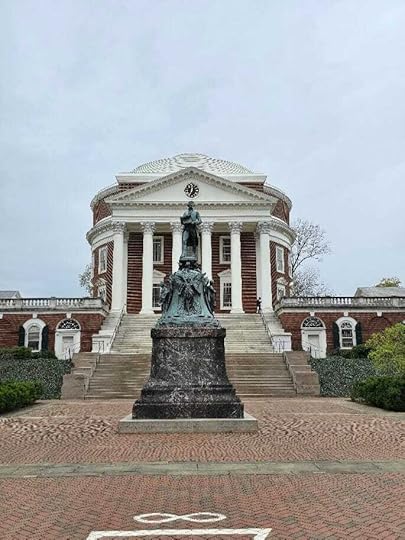 It might be the rain sprinkles on my camera lens that made my UVA photos look wonky here and there, or maybe the herringbone bricks did it, but they are all weird, and I’m having to accept that. This is the Jefferson statue outside the Rotunda at the University of Virginia in Charlottesville.
It might be the rain sprinkles on my camera lens that made my UVA photos look wonky here and there, or maybe the herringbone bricks did it, but they are all weird, and I’m having to accept that. This is the Jefferson statue outside the Rotunda at the University of Virginia in Charlottesville.And here are two views from behind the Jefferson statue, one taken by me on Friday, April 4, 2025 and one (photo credit Getty) on another Friday, August 11, 2017:
“Go there” has been my mantra about writing historical fiction. Go there, if at all possible. Sometimes, of course, it is not. But the benefits of seeing and feeling (and smelling, touching, hearing) a place for yourself are incalculable. Even if you knew it once, like I knew the landscape of my childhood in Countdown, to go back 30 years later is to re-enter that time and place.
I’ve avoided going to Charlottesville partly because I had to, during the pandemic, and partly because I knew that the pulsating energy from the demonstrators and from the protestors, from the living and from the dead, the history of not only those two days but of the ancient days before and the inadequate days since the Unite the Right rally in 2017 would still permeate Charlottesville…. and it does, like a living thing, for better or worse for my wee psyche. But go I did, and I felt that literal vibration with every step I took on Friday.
I’ve written about the saga of trying to write this new book (story here) about the Lost Cause of the Confederacy and the Rise of White Supremacy, having sold it to Scholastic just before the start of the pandemic as my next YA book and then researching deeply and trying to stay in the story through the isolation of lockdown, the unbelievability of Jan. 6, and my agent’s call “Are you sure you want to write this book right now?” and my assertion that I do indeed want to write it (I have had to affirm this, to myself as much as anyone, these past few years), that it is taking the time it takes, given all we have collectively been living through since then, along with big heavy sighs and an admission of my own tender heart feeling brutalized every time I approach the page.
But I’m making progress. I went to Charlottesville for the day on Friday, on the heels of my nearby school visits, and I will be back again soon. I went to Greenwood, Mississippi four times (three for research, one on book tour) while I wrote Revolution, and I have no doubt I’ll be in Charlottesville again and again as well. The first trip is always for a walkabout:
Here I’m trying to get the geography right. I’ll go into detail in Wednesday’s Lab post when we talk about how we write about a place. Maybe you can see, though, how I’m charting a path for my characters, and along the way I need to know the size of objects, what they are made of, the flora along the way, and the path I’m trying to describe… all part of being as authentic as I can be in my story universe.
If you’re interested in writing with fellow Lab Coats (aka Sweethearts of the Storybelly Lab), you can upgrade a free sub and join us in the Lab every week, and every day in Chat, if you wish, right here:

So this week in the Writers Lab we’re starting (the second half of) our Spring Quarter with Notebooks. And in that notebook we’ll be writing about Place. More on Wednesday. If you don’t have a notebook you want to use for assignments this spring, now’s the time to find the just-right one.
This week’s reading — for me — has to do with Charlottesville:
A 220 page “Independent Review of the 2017 Protest Events in Charlottesville, Virginia” researched and compiled by Hunton & Williams
Standing Up to Hate: The Charlottesville Clergy Collective and the Lessons from August 12, 2017 by Michael Cheuk
Cry Havoc: Charlottesville and American Democracy Under Siege by 2017 Charlottesville Mayor Michael Signer.
Eez a lot, as we say around here. I met the Rev. Dr. Alvin Edwards, pastor of Mt. Zion First African Baptist Church, on Friday, and I’m anxious to read Standing Up to Hate then meet with Dr. Edwards again on my next trip.
This week’s outside will be planting seeds — you? Flowers and vegetables.
And maybe I’ll get back to the gym. Bwahahahahahaha!
Actually, in the spring, the edible yard and garden project becomes my gym (not that I won’t get back to the pool, my stretch class, my routines):


I’m proud of the publishing partners who helped give birth to these books, to the teams that have helped them find readers, and I am grateful for every reader who opens these books and sees a bit of history and home, community and compassion. I hope readers connect to their own place in history and home when they read my books. You can find out more about each book, and you can buy them, too, at my website.

I’ve got Charlottesville and the Unite the Right rally heavy on my mind right now. So I’d like to ask you, what does this photo (I’ve got my laptop open to #1 in my reading, above)… what does this photo make you feel? 100 words. Keep for yourself, or put in comments. Word count is optional.
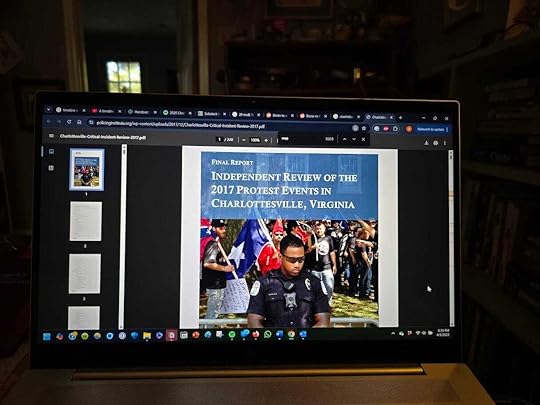
And that’s it for this week’s digest! It’s warm and wet and springy, here in ATL, and I’m counting on a week of good reading and writing ahead. I hope the same for you, those of you who want to/can get to reading and writing… and living, of course!
I’ll leave you with this post by about flooding the zone with light. Yes and Amen. May your zone be flooded with light this week, and may you be the light, if you can, when you can.
We need all the light we can get. Send me some, too.
xoxo Debbie



